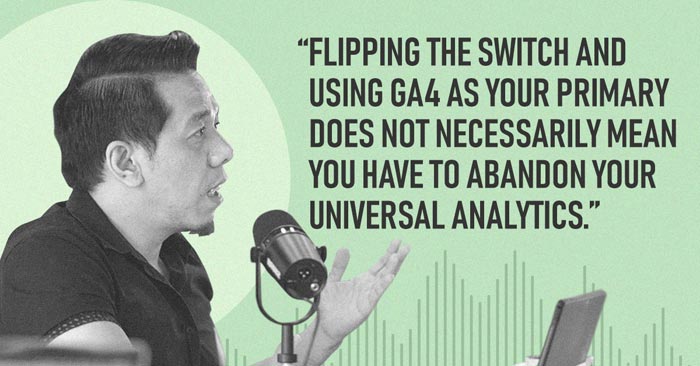Truelogic Episode 15 Recap: Content Marketing 101

Content marketing can help you attract leads, win more sales, and grow your business. At least 47% of buyers view three to five contents before engaging with a sales representative. 72% of B2B marketers say content marketing increases engagement and the number of leads they generate.
In today’s Truelogic DX Podcast, we will guide you through the best content marketing planning process and we’ll teach you how to create the most effective kinds of content to engage your target audience.
Podcast Transcription
Berns San Juan: Hi guys, today we’re going to walk you through some of the best practices for content marketing, at least digital marketing-wise. The planning process and all that happens behind it. I will teach you how to create some of the most effective kinds of content in order for you to engage your audiences.
So, because we’re going to be talking about content, I’ve got a special guest joining me today, welcome Poch!
Pocholo Torres: Hi, I’m Pocholo, an individual that Mr. Berns asks to write content.
Berns San Juan: Why do you think people are not aware that a lot of the work is on the content side?
Pocholo Torres: Well, primarily I think when people hear SEO, they immediately think of technical SEO. All the stuff that goes into the backend, like all the codes and metadata.
Berns San Juan: But to your knowledge, how much of the results is really your hard work versus the technical guys?
Pocholo Torres: A lot, by a large margin.
Berns San Juan: It’s when rankings jump, correct. I think a lot of people don’t appreciate it, although we say it over and over again. Like 80% of what will get you to the first page is the content on the site.
Creating a Content Marketing Plan
1. Get a strategy from SEO analysts
Pocholo Torres: Initially, whenever I get a new campaign to work on, and I get a strategy from our SEO analysts, what I usually think of first is the bigger picture. If this is my task for today, I sort of imagine and foresee how the other tasks are gonna look. Let’s say I get an on-page blog today. Well, usually on month one, we start with a web copy, right and hit the home page.
2. Consider your target audience.
Pocholo Torres: Well, technically when you say empathy and writing, and when we do web copy or on-page blog, or basically whatever type of content we do, one of the things you always consider is our target audience, our reader or our ideal buyer.
Berns San Juan: Are they going to enjoy your content? Will they get it right? And I think this is what most people miss and sadly, by a lot of SEO companies. They’ll produce it based on keyword density, right or word count competition. But in reality, the right way to do it is to produce the content that speaks to the audience.
I think a lot of businesses also blog, but they don’t know why they’re blogging. Businesses with blogs or at least businesses that create fresh content produce about 67% more leads than businesses that don’t. About 47% of users will consume three, four pieces of content from you before they ever engage with your brand.
How Content Marketing Works?
Berns San Juan: Let’s talk about content marketing. It usually begins by understanding the brand. For our clients, what do you need to understand about the brand? What do you need to understand about the audience?
Pocholo Torres: Well, first when we start with the brand, we check the intake. We try to understand how the brand wants to present itself right to their readers. Let’s say a brand sells sneakers, for example. And they want to show their audiences that they are the brand that great athletes prefer instead of presenting themselves as a luxury brand.
Berns San Juan: Or another one might be, we’re the economic choice. We’re the cost effective choice, which is another way a brand could present itself to its audience and then how does a brand pick out its audiences? Like when you guys are writing, who do you assume reads the content? Who do you assume you are producing the content for?
Pocholo Torres: So when we write, we look at this bucket and we generally categorize it into three types of buyers. The business might have the one in the awareness, consideration and conversion stages.
Berns San Juan: So let’s say a person in the audience that’s part of the awareness space. What kind of content do you have to produce for that?
Pocholo Torres: It’s something that talks about the product. I’m sticking with my example, a shoe store, we will talk about the materials that we use and how it benefits them the way the structure of the shoe helps them with their athletics.
Berns San Juan: I think for me an example that might resonate with me, let’s say our smart devices like Fitbit. I actually first heard about Fitbit from people in the office. I haven’t worn a watch in almost 20 years before I got a Fitbit.
I never wear accessories, but awareness content is branded content. Like when I see content about your brand, and then when I see features and benefits, I think a lot of people think, oh no, those are my emotion driving pieces of content. So what I like to remind people is any content that talks about you, that talks about your product, that talks about your brand is just awareness.
This one’s sort of like the most emotionally flat. Like, regardless of how proud you are of it. Consideration part is the more challenging one. So when do you guys get stuck having to produce consideration content?
Pocholo Torres: The middle part is the more challenging one, because it’s either you want to drive traffic, so you need information or you want conversions.
Berns San Juan: And I think the challenge about it is in most cases, when you produce this content, you sort of have to imagine an emotional bullseye?
What’s a good example? Because I’ve done a couple of content experiments inside the Truelogic website. Let’s say I’m producing on-page content for one of the websites, one of the pages inside the Truelogic website and what I’m looking to do is I’m looking to imply your current provider sucks. This is what I’m trying to imply, but that’s an emotional message.
Like you can work with a company where you don’t have to go through hoops. When you guys produce consideration content, where does it get applied to on a website?
Pocholo Torres: It really depends on how the page is constructed. For example, if there’s a wire frame that you’re using, but personally I’d say, you place it in some blogs.
Berns San Juan: Let’s say you have a content calendar that you’re following. I’ll be more specific. Let’s take LBC as an example. They’ve got a lot of product lines. Like they’ve got a lot of service lines, everybody knows they already go door to door. Everybody knows the parcel shipment business thing but not everybody knows about the remittance thing.
When we produce content for it, we’re not trying to get every Palawan user and every MoneyGram user and every Western Union user to switch over to LBC. But when we talk about the remittance service for LBC, we give the audience a specific message. We tell them that we’ve got the widest network, because you hear about all of those other networks. We co-network with them.
I think they even have content that goes as far as up on their Middle East pages. Hey, are you an OFW? Did you know that sending money to your family is as easy as step one, step two, step three? Like it’s super easy. Do you know that you don’t have to account for it? Send, have somebody go to a pickup center and say, “Hey, is my remittance here? Here are the details.” They could go online. They can check. They understand that the remittance product’s emotional impact to let’s say a balikbayan and an OFW are not the same.They’re both overseas Filipinos. But they’re not overseas for the same reasons. So this is an example of where I think consideration content is produced.
What about conversion content? Like what are some of the best examples of conversion content when you guys produce them?
Pocholo Torres: Well, sticking with our current example, LBC. Basically, landing pages.I think it matters because it’s imperative to me the way we construct content that’s targeted to convert leads. There is a bucket that we work with. So content marketing isn’t like a one time thing that you do just right. Do and then it works. Then it’s like a nurturing thing. It’s not set and forget.
So you set, it’s like leaving breadcrumbs of right content that builds up and leads to that landing page. So when you have a newsletter that with the remittance says, for example, you get promos. Send that newsletter to their audience list. And then you have to land them on the page that fulfills that promise. Because your SEO page may not necessarily have been built with that promise in mind.
Berns San Juan: I guess when you guys produce the content and this is why I think you and the marketer really have to talk a lot now because the marketer makes the promise but the content writers sort of stop.
How do you fulfill that promise? So when we create content marketing strategies, I think a lot of people tend to think, or I still see content being produced, but it’s not really very marketing driven where I don’t see the strategy behind it. I still see blogs getting written for the sake of creating blogs. I saw content getting produced for the sake of a content calendar being fulfilled, but that’s sort of, not really the point. There are a lot of elements that go into creating a marketing strategy. To me, one of the most important ones is the buyer persona.
How important is understanding the audience to you guys, that actually produces the content?
Pocholo Torres: It’s very significant for me because basically when I write content, there are a few questions that I have in my mind. Why am I writing this?
Berns San Juan: Can you give me an example of a brand that you have worked on where you feel the audience was very distinct?
Pocholo Torres: I had this campaign that focused on engineering wood, wooden floors. So I felt like the target buyer for that was really, it changed from broad to very distinct. What type of person would go out of their way to search online for wood flooring supplies, as opposed to like the layman would typically go.
Berns San Juan: Which buyer persona am I working with here? Because a brand can have multiple ones. Have you ever had to wrestle with when you’re producing content?
Pocholo Torres: Well, for example, with that campaign, I sometimes had to decide whether I was writing for a decision maker. Let’s say someone who had an office space. So he had to decide which type of flooring. So it’s a commercial office space. So you need a lot. It’s gonna be worth a lot or are you looking for a homeowner? Like an individual owner just needed a small amount.
Berns San Juan: That’s a very distinct difference. Somebody that wants flooring for an office space versus somebody that wants it for their home. Who did you wind up writing the piece for, for the office? You wrote it for the office space person. So that’s a good approach. How do you know if the content is working? So you figured out, so here’s the brand, here’s what they promise. Here’s the person that I think this content will speak to. How do you know if you hit that bullseye?
Pocholo Torres: Well it’ll also depend on the campaign’s KPIs, right or what were their objectives? Was it to drive traffic? So I usually consult with the SEO right after implementation.
Berns San Juan: So when is it good news to you though? Like how do you know you did a good job on the content?
Pocholo Torres: Well, it’s either we get client feedback. The health score jumps.
Berns San Juan: I also tell people that when you produce content, have a friend look over it, right? I think the worst judge of how good or bad a piece of content is the marketer, which tends to be what happens most of the time. Most marketing pieces are assessed by marketers which I think is a bad idea. Have somebody that looks like their target audience evaluate the content because that’s pretty good objective feedback. I also think it sort of depends, doesn’t it, on which of you, if you produce the content for awareness then you wanna measure how many eyeballs, how many impressions? If the objective is information, then you sort of lean on the traffic, like meaning you get your kicks out of how many people got to see the article.
If the page was designed for, let’s say conversion then clearly, you know, how many inquiries did you drive? How many sales did it drive is sort of the metric that determines whether you were successful or not? How much research goes into a piece of content?
Pocholo Torres: It depends on me really which you are on. The niche of the campaign.
Berns San Juan: Let’s go back to LBC. How much research did you have to do for remittance?
How much research would’ve had to go for you to produce, let’s say, a landing page for remittance?
Pocholo Torres: Well, not a lot since the most that I would do for it is create an account to write about it. So going back, so you can empathize with the user, like write about how, what they’re going to experience right.
Impact of Content Marketing
Berns San Juan: I think one of the most important things I like to remind clients is it doesn’t end when we produce the content. It begins when we produce the content. There is no singing fat lady until it’s on your website. I think some of our content, sometimes they bottleneck somewhere and it takes something we produced for February we might not see go live until June. If they implemented it sooner, they reap the benefits of that content that was produced significantly sooner. Measure the results, find out. Did my work have an impact?
Best Practices in Content Marketing
1. Look up what your competitors are doing
Pocholo Torres: First is to look up your competitors on what they’re doing. I hate to say it, but word count kind of matters. And the average it’ll be around 1500 to 1800. That’s what Google says that works best. So look up what your competitors are doing, see what they’re not doing. But word count and on the other side of things, you’ll need to keep the content relevant.
2. Infographics
Pocholo Torres: Of course it has to be factual, it has to be based on your statistics, so that’s good advice. Don’t lie on your infographics. It’s so easy to come up with a fake. Keep it short and sweet for your readers.
Berns San Juan: If I were to translate that, what I would say is keep it snackable, right? When you create infographics, like create something that viewers can appreciate in like five seconds and zero-in on the most important piece to them.
3. Video
Pocholo Torres: First off, consider what your objective is. There are two ways that you can approach video. You could go long form or TikTok level, like three, five minutes or even just 15 seconds. You just want to be everywhere all at once. So you have to consider objectives first before producing the video.
4. eBooks
Pocholo Torres: eBooks, it’s always a best practice. If you’re a brand and you’re using an ebook, make it free. Don’t turn it into a novel.
5. Testimonials
Berns San Juan: When we pick out case studies and testimonials to publish on the website, how do we pick one that is good enough to publish on the site?
Pocholo Torres: Of course, we’re going to go with the ones that are exceptional, the ones that provide real value. I can differentiate a generic testimonial from one that really impacted our clients to me.
Berns San Juan: I think the testimonials I like seeing go up on Truelogic are the ones where the clients either talk about the results. No brainer and then the other is the experience with the team. Because I think ultimately those are the two things that we sell. We sell the experience and we sell the results.
6. Social media posts
Pocholo Torres: Make it short, sweet, and eye-catching. Everybody’s scrolling and everybody’s competing. It’s an infinity scroll platform.
7. Email marketing
Pocholo Torres: As much as we can do away with generic stuff, keep your emails personalized.
Berns San Juan: I’ll give you an example. One of the reasons why I’m no longer on Zalora’s mailing list is once upon a time they sent me a newsletter for stilettos on sale.
I’m five foot eight and I do not need stilettos. I am relatively tall. Your customers are not monoliths. They’re all different. But at the minimum, be sensitive to what gender they’re in or economic class or whatever.
Let’s say if there was a writer listening to you, what advice would you give if there was a marketer listening to you?
Pocholo Torres: It’s to always look ahead, at least, I guess if you can be a month or three months ahead when it comes to crafting your content for a campaign because it’ll only hurt later on when you have to restructure everything. So you have to plan it out. Consider your objectives, how the brand wants to present themselves.
Berns San Juan: Especially if the content is for SEO, it will take a while. Like it is momentum-driven. It takes a while for it to have an impact.
Pocholo Torres: You have to carefully consider the bigger picture.
Berns San Juan: So is that advice for the writer or the marketer?
Pocholo Torres: It’s for both. It’s collaborative, unless you do both things.
Berns San Juan: I would say still rare, but I think there are starting to be people that are like that and I think with that piece of advice, I’ll wrap up our episode of this Truelogic DX podcast. We hope you guys enjoyed this episode again.
Thank you Poch for joining me on this round and to our listeners, thank you for joining us here. Give us a shout out on social media. If you have any comments and would like to see us go more in depth on this topic, feel free to drop your suggestions.
Don’t forget to tune in and subscribe to our Spotify, Google, and Apple accounts.










